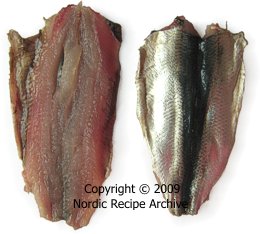
|
|||||||||||||||
| MAIN RECIPE PAGE |
|
||||||||||||||
|
FRIED BALTIC HERRING FILLETS
Note that the two fillet halves are not separated, but left attached by the skin, ie the fish is opened up on the middle like a book. Two of these "double fillets" are then pressed together and fried. about 500 - 700 g small Baltic herring fillets or about 1 kg whole small Baltic herrings If you are using whole Baltic herrings, gut and clean them following the illustrated instructions given here. Pair the herring fillets matching those of equal size (see figure 1 below). Place one half of the fillets flat and skin-side down on the work surface and lightly season with salt and pepper, then evenly distribute the chopped dill on top (see figure 2 below). See a hint for chopping herbs, a method especially suitable for delicate herbs like dill.
Take the other half of fillets and place on top of the seasoned ones, now skin-side up. Press lightly together to produce stuffed "herring steaks" (see figure 3 below). Spread a thick layer of rye flour on a deep plate. (If you like, you can season the flour with some salt and pepper.) Taking one "herring steak" at a time, press it into the flour on both sides to coat them (see figure 4 below).
Melt and heat some butter in a skillet. Needless to say, stuffed Baltic herring fillets are always fried using real butter only! Lower the heat and fry the fillets in batches, for about 3 to 5 minutes per side, or until just done.
Place the herring fillets evenly on top in one layer (see the picture on right). Bake at 275 °C for a few minutes per side, or until done, turning the fillets over once during baking. Serve the fillets immediately with potato puree, chopped dill, slice of lemon and a drizzle of melted butter. In addition, I sometimes like to serve whipped crème fraîche seasoned with horseradish, salt, white pepper, a pinch of sugar and a dash of lemon juice. Instead of the traditional dill, you can use a multitude of other ingredients as the filling for the fillets — chopped fresh herbs, chives, scallion or onion, horseradish, fresh tomato or tomato puree, mustard, anchovies, smoked cod roe paste, chopped hard-boiled eggs, or whatever you fancy.
Serving and storing suggestions: Recipe source: family recipe/traditional Finnish recipe. |
|||||||||||||||
|
 For this recipe, either whole or filleted small
For this recipe, either whole or filleted small 



 The fillets — especially larger batches — may also be baked in oven. Cover a large, deep oven pan with parchment paper and drizzle generously with
The fillets — especially larger batches — may also be baked in oven. Cover a large, deep oven pan with parchment paper and drizzle generously with